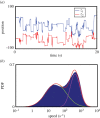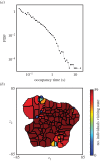Mapping the stereotyped behaviour of freely moving fruit flies
- PMID: 25142523
- PMCID: PMC4233753
- DOI: 10.1098/rsif.2014.0672
Mapping the stereotyped behaviour of freely moving fruit flies
Abstract
A frequent assumption in behavioural science is that most of an animal's activities can be described in terms of a small set of stereotyped motifs. Here, we introduce a method for mapping an animal's actions, relying only upon the underlying structure of postural movement data to organize and classify behaviours. Applying this method to the ground-based behaviour of the fruit fly, Drosophila melanogaster, we find that flies perform stereotyped actions roughly 50% of the time, discovering over 100 distinguishable, stereotyped behavioural states. These include multiple modes of locomotion and grooming. We use the resulting measurements as the basis for identifying subtle sex-specific behavioural differences and revealing the low-dimensional nature of animal motions.
Keywords: Drosophila; behaviour; phase reconstruction; stereotypy; unsupervised learning.
Figures



 , after inverse Radon transform. Black and white regions represent highlighted areas of each mode (with opposite sign). (c) First 1000 eigenvalues of the data matrix (black) and shuffled data (red). (d) Fraction of cumulative variation explained as a function of the number of modes included. (e) Typical time series of the projection along postural mode 6 and (f) its corresponding wavelet transform.
, after inverse Radon transform. Black and white regions represent highlighted areas of each mode (with opposite sign). (c) First 1000 eigenvalues of the data matrix (black) and shuffled data (red). (d) Fraction of cumulative variation explained as a function of the number of modes included. (e) Typical time series of the projection along postural mode 6 and (f) its corresponding wavelet transform.







References
-
- Lehner PA. 1996. Handbook of ethological methods, 2nd edn Cambridge, UK: Cambridge University Press.
-
- Gould JL. 1982. Ethology: the mechanisms and evolution of behavior. New York, NY: W. W. Norton and Company.
-
- Glimcher PW, Dorris M. 2004. Neuronal studies of decision making in the visual-saccadic system. In The cognitive neurosciences III (ed. Gazzaniga MS.), pp. 1215–1228. Cambridge, MA: MIT Press.
Publication types
MeSH terms
Grants and funding
LinkOut - more resources
Full Text Sources
Other Literature Sources
Molecular Biology Databases
